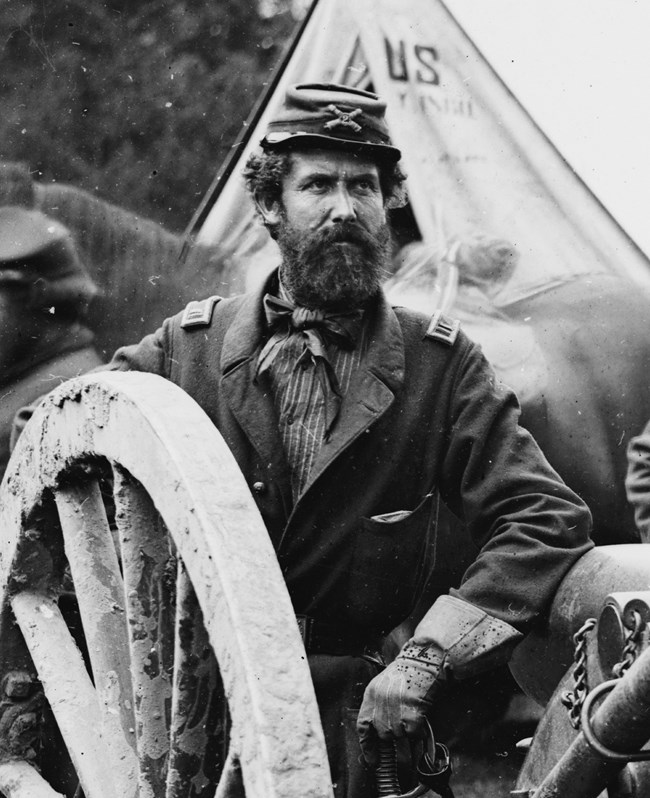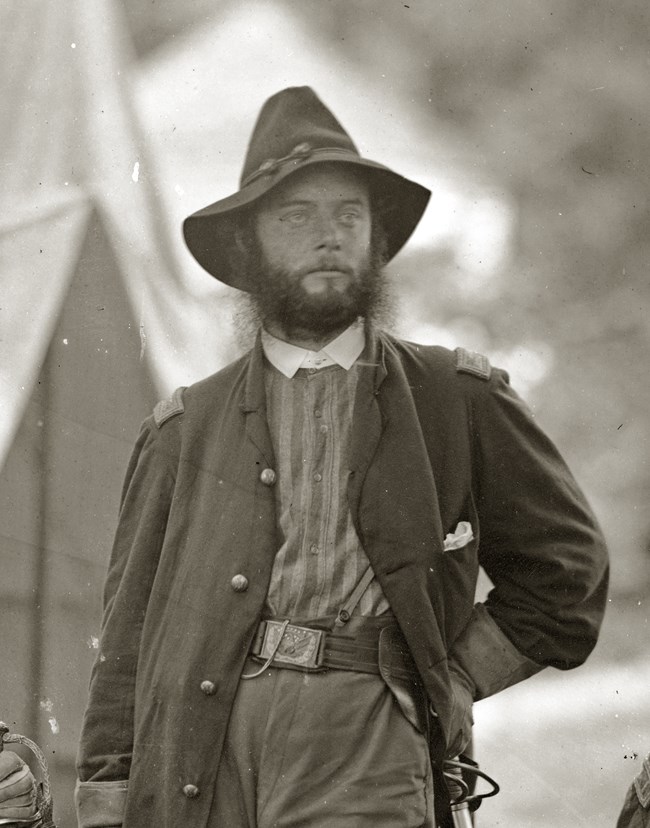“No other equal area on the American continent has been so drenched in human blood.”Capt. John C. Tidball, Battery A, 2nd U.S. Artillery
Library of Congress IntroductionThis .3-mile uphill trail (one way) will take you to the position of Battery A, 2nd United States Artillery, commanded by Capt. John C. Tidball. Tidball and his battery of six 3-in. ordnance rifles were part of an advance made by Union infantry, cavalry, and artillery over the Middle Bridge. His position is one of the best views found anywhere on the battlefield.
Tidball's advance was part of a general advance made by the 5th Corps, commanded by Gen. Fitz John Porter. At about 4:00 p.m., Union cavalry, artillery and United States regular infantry had pushed to the edge of Sharpsburg. These troops connected the 2nd Corps to the north with the 9th Corps to the south. General Lee responded by moving more artillery to the high ground where the National Cemetery is today. Some of these guns had fought in the early morning action around the Dunker Church. It was at the peak of this advance when Confederate General A.P. Hill and his division arrived from Harpers Ferry and struck the left flank of the 9th Corps, which in turn exposed the left flank of the 5th, which pulled back. There were over 600 casualties in the fighting here at the Middle Bridge, about the same number as there were at the Burnside Bridge. 
Tidball reported that at around 10:00 a.m. "I was ordered to cross the turnpike bridge over the Antietam where I took position on the right of the road. In front the enemy's Sharpshooters were posted and there being no infantry at hand to drive them back, I opened fire upon them with Canister, and gradually worked my guns by hand up a steep ploughed field to the crest of the hill where I placed them in a commanding position not only for the enemy directly in front, but for an enfilading fire in front of Sumner's Corps on the right and that of Burnside on the left of me. The enemy's batteries all the while were very active, but with some exception his practice was bad....On the 17th I had one private--Hitz killed, and one severely and two slightly wounded and 10 horses killed. I fired in all about 1,200 rounds."

Library of Congress Tidball was born in what is today West Virginia in 1825. He graduated from West Point in 1848 and served in the Seminole War as an artillery officer. His battery was in Charles Town for the hanging of John Brown, and it was in Washington for Lincoln’s First Inauguration. During the Civil War he fought in every major battle in the east and was breveted (honorary promotion) five times for gallant and meritorious service on the battlefield, reaching the rank of Major General of volunteers. Including his time as a student at West Point, Tidball's career spanned forty-five years with service in nine states, including a time as the military commander of the District of Alaska. He was the Commandant of Cadets at West Point, Superintendent of Artillery Instruction at Fort Monroe, and wrote the Army's Manual for Heavy Artillery. 
Library of Congress Across the road on the North side of the Boonsboro Turnpike, Col. James H. Childs of the 4th Pennsylvania Cavalry was in temporary command of Averell’s Brigade at Antietam. He was leading the brigade across the Middle Bridge onto the Newcomer Farm when he was struck in the hip by an artillery round that killed two soldiers and four horses. After his wounding, Col. Childs continued tending to his military duties, then sent a message to the surgeons that “if not attending to any one whose life could be saved, to come to him, as he was in great pain.” He died less than an hour later leaving a widow and three children home in Pittsburgh. There is a monument to Col. Childs across Rt. 34 from the Newcomer house. |
Last updated: March 25, 2021
